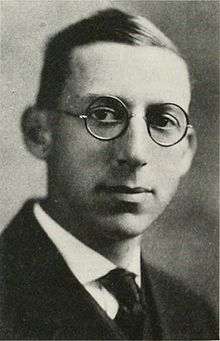William B. Greeley
William Buckhout Greeley (1879–1955) was the third chief of the United States Forest Service, a position he held from 1920 to 1928.[1] Greeley was born September 6, 1879, in Oswego, New York, to parents Frank Norton Greeley, a Congregational clergyman, and Anna Cheney (Buckhout) Greeley. He graduated from the University of California, Berkeley in 1901, and received a Master of Forestry degree from Yale University in 1904.[2] In 1924 he established the first wilderness area in the United States: Gila Wilderness in Gila National Forest, New Mexico.[3]

After finishing at the top of the first Yale forestry graduating class of 1904, Greeley was handpicked by Gifford Pinchot to be the Forest Service's Region 1 forester. In that position, he had responsibility over 41 million acres (170,000 km2) in 22 National Forests in four western states (all of Montana, much of Idaho, Washington, and a corner of South Dakota).[4]
One year after the Great Fire of 1910 Greeley received a promotion to a high administration job in Washington. In 1920, he became Chief of the Forest Service. The fire of 1910 convinced him that Satan was at work, and elevated firefighting to the raison d'être — the overriding mission — of the Forest Service.[4] Under Greeley, the Service became the fire engine company, protecting trees so the timber industry could cut them down later at government expense. Pinchot was appalled. The timber industry successfully oriented the Forestry Service toward policies favorable to large-scale harvesting via regulatory capture, and metaphorically, the timber industry was now the fox in the chicken coop.[5] Pinchot and Theodore Roosevelt had envisioned, at the least, that public timber should be sold only to small, family-run logging outfits, not to big syndicates. Pinchot had always preached of a "working forest" for working people and small-scale logging at the edge, preservation at the core. In 1928 Bill Greeley left the Forest Service for a position in the timber industry, becoming an executive with the West Coast Lumberman's Association.[6]
When Pinchot traveled west in 1937, to view those forests with Henry S. Graves, what they saw "tore his heart out." Greeley's legacy, combining modern chain saws and government-built forest roads, had allowed industrial-scale clear-cuts to become the norm in the western national forests of Montana and Oregon. Entire mountainsides, mountain after mountain, were treeless. "So this is what saving the trees was all about." "Absolute devastation", Pinchot wrote in his diary. "The Forest Service should absolutely declare against clear- cutting in Washington and Oregon as a defensive measure", Pinchot wrote.[7]
References
- Morgan, George T. Jr. (1961). William B. Greeley: A Practical Forester. St. Paul, Minnesota: Forest History Society, Inc.
- Yale University. Dept. of Forestry (1913). Biographical Record of the Graduates and Former Students of the Yale Forest School. Yale Forest School. pp. 77–78.
- Steen, Harold K. (2004). The U.S. Forest Service: A History. University of Washington Press. p. 155. ISBN 978-0-295-80348-7.
- "The Big Burn-Transcript". American Experience. PBS. 3 February 2015. Retrieved 23 January 2019.
- Egan, Timothy, 2009, The Big Burn: Teddy Roosevelt & the Fire That Saved America, p.270-271. Houghton Mifflin Harcourt ISBN 978-0-618-96841-1
- Egan, Timothy, 2009, The Big Burn: Teddy Roosevelt & the Fire That Saved America, p.281. Houghton Mifflin Harcourt, ISBN 978-0-618-96841-1
- Egan, The Big Burn at p.272.
External links
| Wikimedia Commons has media related to William B. Greeley. |